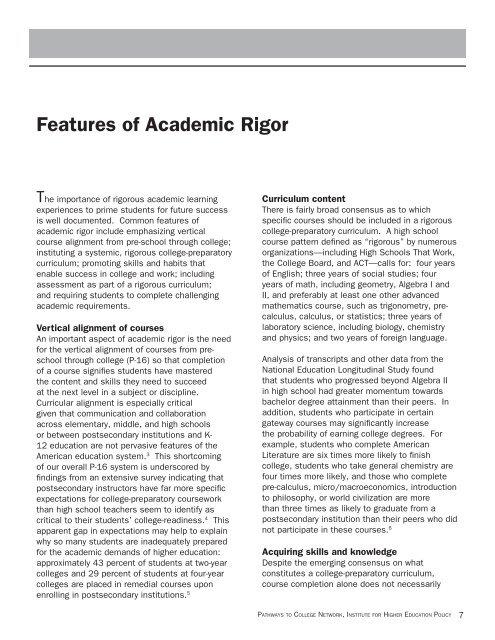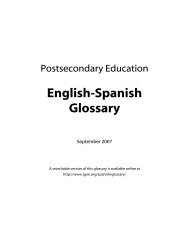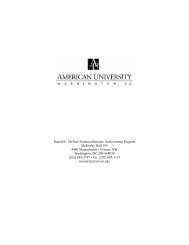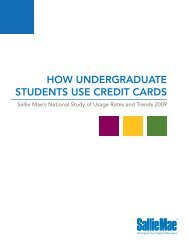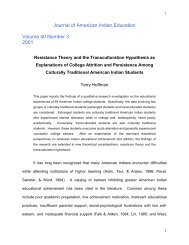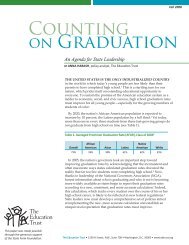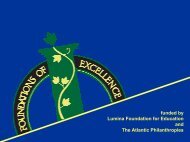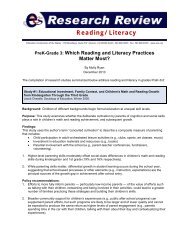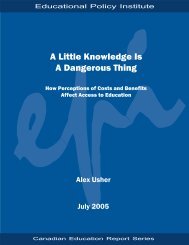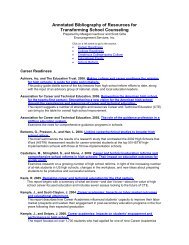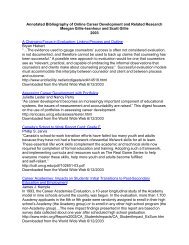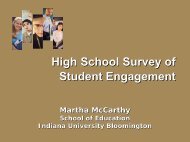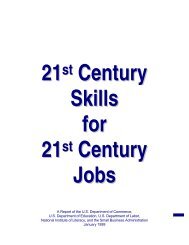Removing Roadblocks to Rigor: Linking Academic and Social ...
Removing Roadblocks to Rigor: Linking Academic and Social ...
Removing Roadblocks to Rigor: Linking Academic and Social ...
Create successful ePaper yourself
Turn your PDF publications into a flip-book with our unique Google optimized e-Paper software.
Features of <strong>Academic</strong> <strong>Rigor</strong><br />
The importance of rigorous academic learning<br />
experiences <strong>to</strong> prime students for future success<br />
is well documented. Common features of<br />
academic rigor include emphasizing vertical<br />
course alignment from pre-school through college;<br />
instituting a systemic, rigorous college-prepara<strong>to</strong>ry<br />
curriculum; promoting skills <strong>and</strong> habits that<br />
enable success in college <strong>and</strong> work; including<br />
assessment as part of a rigorous curriculum;<br />
<strong>and</strong> requiring students <strong>to</strong> complete challenging<br />
academic requirements.<br />
Vertical alignment of courses<br />
An important aspect of academic rigor is the need<br />
for the vertical alignment of courses from preschool<br />
through college (P-16) so that completion<br />
of a course signifies students have mastered<br />
the content <strong>and</strong> skills they need <strong>to</strong> succeed<br />
at the next level in a subject or discipline.<br />
Curricular alignment is especially critical<br />
given that communication <strong>and</strong> collaboration<br />
across elementary, middle, <strong>and</strong> high schools<br />
or between postsecondary institutions <strong>and</strong> K-<br />
12 education are not pervasive features of the<br />
American education system. 3 This shortcoming<br />
of our overall P-16 system is underscored by<br />
findings from an extensive survey indicating that<br />
postsecondary instruc<strong>to</strong>rs have far more specific<br />
expectations for college-prepara<strong>to</strong>ry coursework<br />
than high school teachers seem <strong>to</strong> identify as<br />
critical <strong>to</strong> their students’ college-readiness. 4 This<br />
apparent gap in expectations may help <strong>to</strong> explain<br />
why so many students are inadequately prepared<br />
for the academic dem<strong>and</strong>s of higher education:<br />
approximately 43 percent of students at two-year<br />
colleges <strong>and</strong> 29 percent of students at four-year<br />
colleges are placed in remedial courses upon<br />
enrolling in postsecondary institutions. 5<br />
Curriculum content<br />
There is fairly broad consensus as <strong>to</strong> which<br />
specific courses should be included in a rigorous<br />
college-prepara<strong>to</strong>ry curriculum. A high school<br />
course pattern defined as “rigorous” by numerous<br />
organizations—including High Schools That Work,<br />
the College Board, <strong>and</strong> ACT—calls for: four years<br />
of English; three years of social studies; four<br />
years of math, including geometry, Algebra I <strong>and</strong><br />
II, <strong>and</strong> preferably at least one other advanced<br />
mathematics course, such as trigonometry, precalculus,<br />
calculus, or statistics; three years of<br />
labora<strong>to</strong>ry science, including biology, chemistry<br />
<strong>and</strong> physics; <strong>and</strong> two years of foreign language.<br />
Analysis of transcripts <strong>and</strong> other data from the<br />
National Education Longitudinal Study found<br />
that students who progressed beyond Algebra II<br />
in high school had greater momentum <strong>to</strong>wards<br />
bachelor degree attainment than their peers. In<br />
addition, students who participate in certain<br />
gateway courses may significantly increase<br />
the probability of earning college degrees. For<br />
example, students who complete American<br />
Literature are six times more likely <strong>to</strong> finish<br />
college, students who take general chemistry are<br />
four times more likely, <strong>and</strong> those who complete<br />
pre-calculus, micro/macroeconomics, introduction<br />
<strong>to</strong> philosophy, or world civilization are more<br />
than three times as likely <strong>to</strong> graduate from a<br />
postsecondary institution than their peers who did<br />
not participate in these courses. 6<br />
Acquiring skills <strong>and</strong> knowledge<br />
Despite the emerging consensus on what<br />
constitutes a college-prepara<strong>to</strong>ry curriculum,<br />
course completion alone does not necessarily<br />
PATHWAYS TO COLLEGE NETWORK, INSTITUTE FOR HIGHER EDUCATION POLICY 7


